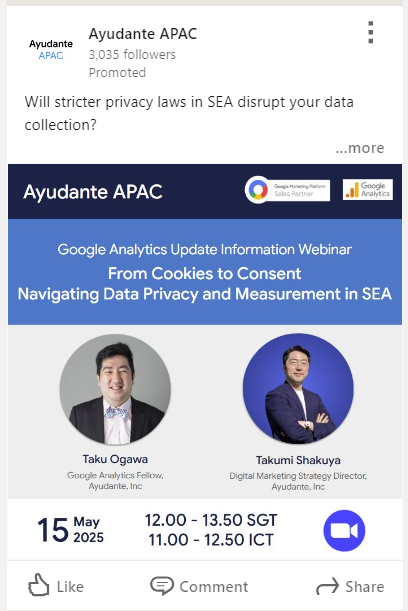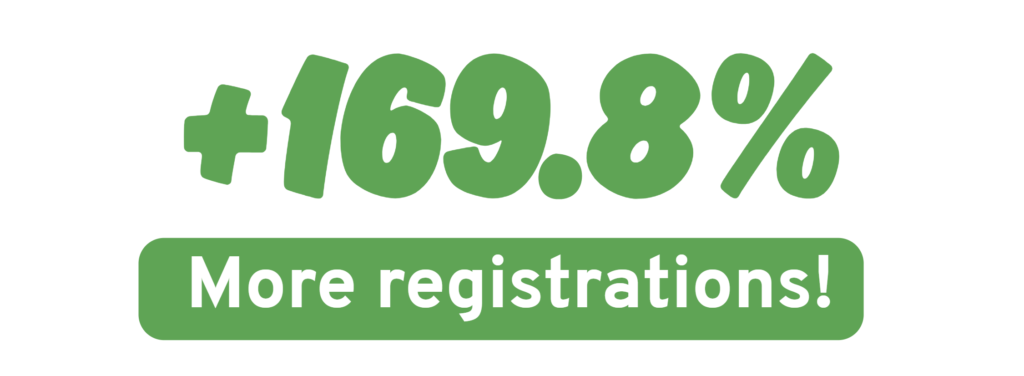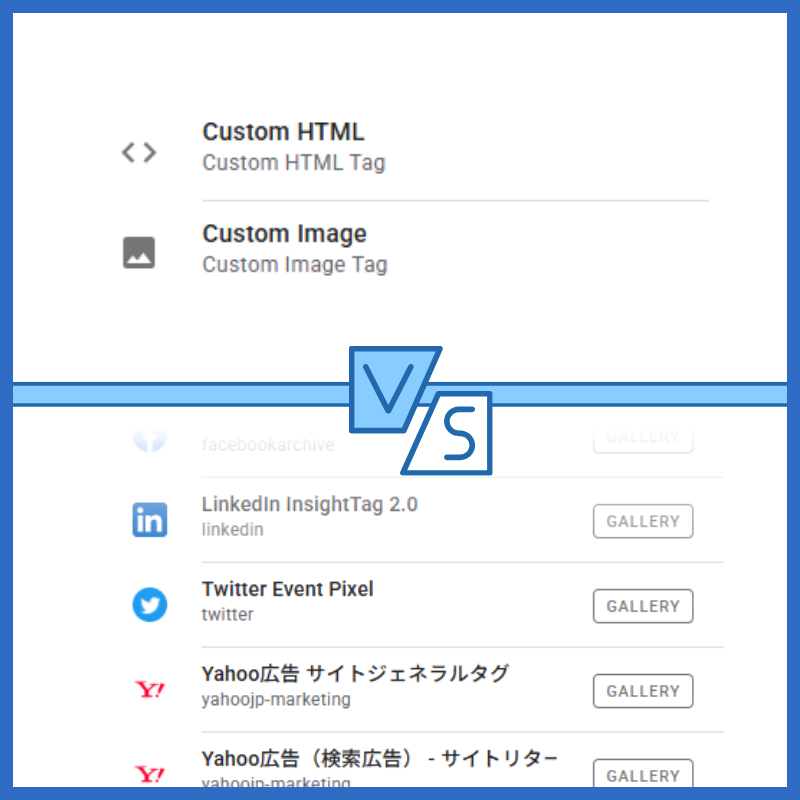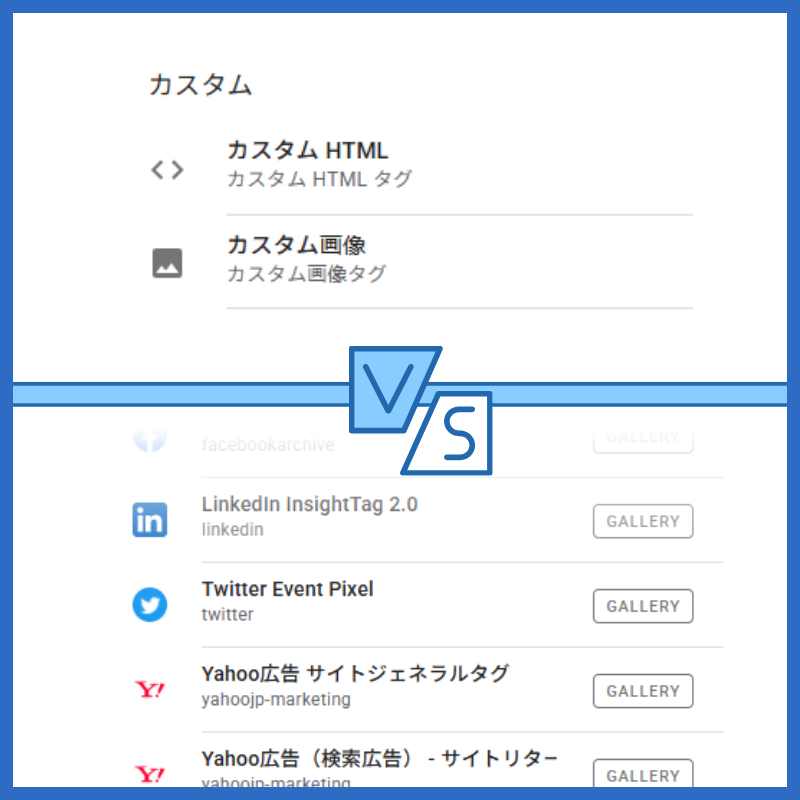

In May 2025, our sister team in Singapore, Ayudante APAC, had the challenge to drive registrations for an online webinar. In this post, we explore how we leveraged LinkedIn to generate registration leads.
- Background and Challenge
- Leaning On LinkedIn
- Audience Targeting
- Assets and Creative Performance
- The Results
Background and Challenge
The event was titled “Navigating Data Privacy and Measurement in SEA”. The event focused on evolving data privacy practices in Southeast Asia and Google Analytics, attracting professionals interested in staying ahead of data regulation changes.
While our teammates in Singapore had organized webinars before and had used various paid media for promotion, this time the team was equipped with learnings from previous webinars, which led them to decide to lean on LinkedIn for web registrations.
The result: SUCCESS!
Considering our results, wanted to share some of the learnings from this initiative, and perhaps provide some tips!
Leaning on LinkedIn
Previous webinar campaign promotions had suggested LinkedIn had potential for this type event. Doubling down on what worked, the team decided to heavily lean on LinkedIn this time.
To maximize reach and registration efficiency, we executed a multi-format ad strategy. The approach assumed we would test new formats, learn and quickly evolve tactics while running the campaign. The team was on top of the campaign reports on a daily basis, balancing between giving an opportunity for the LinkedIn algorithm to do its job, reallocating budget to a different campaign, and creating a completely new one.
Audience Targeting
One of LinkedIn’s key strengths is its ability to let advertisers target audiences using first-party data. Professionals on LinkedIn share, directly or indirectly, their industry, years of experience, titles, companies, and other data points that allow us to create reliable audiences.

The target audience for this event: marketing professionals and decision makers in Singapore, Malaysia, Thailand, Indonesia and Vietnam. Other demographic filters such as years of experience, interests, and more were also applied.
For this initiative, we tried audiences ranging from 80k to 500k users depending on the region and type of campaign. We also used matched audiences to reach out to current clients and known contacts who we believed would be interested.
We also leveraged the LinkedIn Insights tag to create remarketing audiences based on website actions to either include or exclude users from other campaigns.
Assets and Creatives Performance
Throughout the campaign, the team experimented with a variety of ad formats and creative combinations to identify what resonated best with their target audiences. This allowed for testing not only of layout and visuals but also messaging styles and engagement tactics. Below are the formats that were tested:
Carousel Ads
Carousel Ads allow multiple creatives (or cards) within a single ad, making them effective for storytelling, showcasing product features, highlighting different aspects of an event, or in this case, multiple presenters.
Strengths:
The format encourages engagement by prompting users to swipe through content, and it’s well-suited for visually segmenting information — such as featuring one speaker per tile in event promotions. It balances branding and detail without overwhelming the viewer.
Weaknesses:
Performance can vary depending on creative execution. If the first card doesn’t capture attention, users may not engage with the rest. It also requires more design effort to maintain consistency across cards.

In Our Case:
We leaned on Carousel type ads with an initial 50% allocated budget. Carousel ads were not tried in previous webinar campaigns, which made for entertaining speculation on performance. While the team liked the way the carousel ads can present multiple speakers and ideas in a very digestible format, performance did not live to the hype.
Carousel ad performance was not significantly better than single image ads executed in previous campaigns – with one exception: once we introduced Lead Gen forms, the conversion rate increased significantly! The increase in performance was likely due to the lead gen form over the ad type, but we will keep testing.
InMail Messages
InMail Messages offer a direct line to targeted LinkedIn users through their inboxes, making them ideal for reaching well-defined, high-value audiences with personalized content like webinar invitations or offers.

Strengths:
This format excels in precision targeting and message personalization. It’s especially effective for small, focused campaigns where the goal is relevance over reach. Messages typically achieve high visibility due to their inbox placement.
Weaknesses:
InMail isn’t built for scale — frequency limits and inbox fatigue can impact performance. Engagement depends heavily on message quality, and costs can be higher compared to other ad types.

In Our Case:
This was the most effective ad type. Performance for this type of ad improved as we fine-tuned the audience. We created various campaigns depending on geographies and audience attributes. Our best InMail campaign audience was narrowed to about 60k users. It is possible to argue for a narrower or wider audience. Next time we are likely to test a narrower audience.
We also tried Lead Gen forms with this type of ad and, no surprise, Lead Gen forms performed better!
Boosted Single Image Ads
Boosting a single image post is one of the simplest ways to advertise on LinkedIn, often used to quickly amplify existing organic content without building a full campaign. We wanted to try this type of ad as a comparison point against more robust traditional campaigns.

Strengths:
This method is fast to deploy and leverages existing posts, making it useful for testing interest or extending reach with minimal setup. It’s especially effective when the original content already has some traction.
Weaknesses:
Boosted ads offer fewer customization and targeting options compared to building a native campaign in Campaign Manager. Creative and placement limitations may restrict optimization and control.

In Our Case:
The team built on previous learnings about what worked and what didn’t — for the creatives, style, and information displayed. Single image ads (boosted, in the case) performed similarly to the carousel ads. Considering carousel ads require more creative work, we will likely rethink the approach and the type of messaging we showcase with carousel ads. Meanwhile, single image ads seem to be the most versatile and effective format considering our creative types, audience, and geography.
The Results
Ayudante APAC used a combination of metrics to understand performance including Google Analytics and LinkedIn analytics.
The team generated 169.8% more registrations (2.65×) than their next best-performing webinar in the past. Thanks to a combination of tactics and ongoing optimization, the team significantly exceeded their target.

We look forward to the next opportunity to create and challenge hypotheses around ad types, creatives and approaches!
If your organization would like support with LinkedIn campaigns, contact us. We’d be happy to help!

(グローバル)






![[GA4]機能紹介:生成インサイト](https://ayudante.jp/wp-content/uploads/2025/10/GA4.png)

